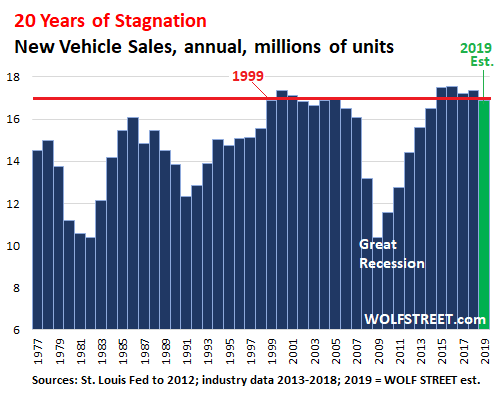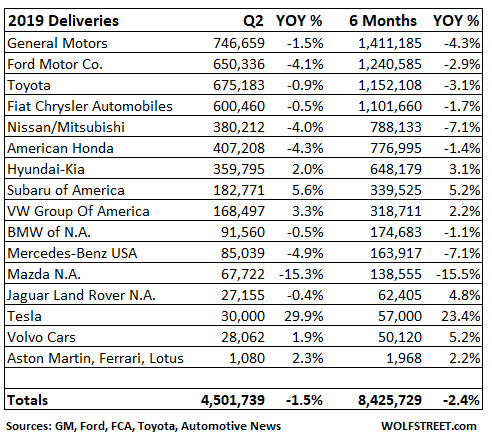Wolf Richter wolfstreet.com, http://www.amazon.com/author/wolfrichter
Carmageddon for cars. But big equipment is hot and gets pricier.
Ford waited until today to report its second-quarter new-vehicle deliveries in the US. So now we know what happened to total US auto sales in the second quarter and in the first half this year, and it wasn’t pretty. New-vehicle deliveries, fleet and retail combined, fell 1.5% in Q2 compared to Q2 last year, to 4.5 million vehicles; and in the first half fell by 2.4% to 8.4 million vehicles.
This puts new vehicle sales on track to fall below 17 million units for the year. This would be the worst level since 2014. According to my own estimates, new vehicle sales in 2019 will decline to 16.95 million units, roughly on par with 1999, in a horribly mature market, whose two-decade stagnation was interrupted by the excitement of a collapse and recovery back to stagnation levels:

Ford sales fell 4.1% in Q2.
Ford [F], like GM, stopped reporting monthly vehicle sales, and now only reports on a quarterly basis. In the second quarter, reported this morning, sales fell 4.1% to 650,336 units. This put Ford into third place, behind GM and Toyota.
Carmageddon: This is the big shift where Americans refuse to buy new “cars” and instead are buying new pickups, SUVs, compact SUVs, and vans. And they have far higher price tags and profit margins than cars. Ford’s car sales plunged another 21.4% to just 110,195 units in Q2, continuing their multi-year collapse.
Trucks (not including SUVs) are hot: Sales rose 7.5% to 324,243 units. But within that category, F-series pickups fell 1.3% to 233,787 units, getting cannibalized by Ford’s mid-size pickup, the Ranger, that it had brought back from the dead for the 2019 model year.
But Ford’s SUV sales are cold, disconcertingly falling 8.6% to 215,898 units.
Ford – along with other automakers – brags about how it is able to raise prices. It even explains its strategy in its report, meant for Wall Street, not consumers. It reported proudly that the average transaction price (ATP), which includes all incentives, for the 2019 Lincoln Nautilus SUV rose by $3,700, or 9%, to $44,300 in Q2, compared to the 2018 Lincoln MKX in Q2 last year.
These are the same vehicles, with a new name, a 9% higher ATP, a couple of updates, and about the same cost of manufacturing. Wall Street loves this strategy because Ford just increased its revenues and profit margins at the expense of the consumer – and consumers love getting jacked around like this, obviously, because deliveries jumped 13%.
Ford also brags about the price increases of its flagship product, F-series pickups, whose sales declined. The ATP for the F-series, which range from a base work truck to fully decked out crew cabs and beyond, rose by $1,200, to $47,500.
But Ford’s cheapest vehicle – a car! – had a huge gain in sales: Fiesta deliveries jumped 70% in the quarter to 22,173 vehicles, and are up 50% so far this year. This is now Ford’s second-bestselling car, after the Fusion (+11% year-to-date). All other car models are dying, with the Mustang (-9% year-to-date) dying more slowly than the Focus (-83%) and the Taurus (-47%).
The fact that Fiesta sales are hot shows that there is demand for decent entry-level cars, despite Carmageddon. But with a base sticker price of $14,200, there is very little profit margin for Ford, and it has no incentive to market them other than meeting Corporate Average Fuel Economy (CAFE) Standards.
GM sales fell 1.5% in Q2.
GM [GM] slows the decline. Sales had plunged 7% in Q1 compared to a year earlier. In Q2, sales fell only 1.5% to 746,659 units, GM reported yesterday. Its report is all about trucks, SUVs, and crossovers, with lots of details on trucks.
But the word “car” is mentioned only once, in passing, and without a number, in this phrase: “The company estimates that its retail market share was even with a year ago, with truck and crossover deliveries offsetting lower passenger car sales.” And that was it. Carmageddon.
Expensive crew cab pickups are hot: Sales of the Chevrolet Silverado 1500 crew cab and GMC Sierra 1500 crew cab jumped 12%.
And GM, like Ford, brags about price increases. The ATP of all its sales rose by $1,575, or 4.4%, to $37,126.
FCA sales fell 0.5% in Q2.
Fiat Chrysler Automobile [FCAU] still reported deliveries on a monthly basis. But it announced yesterday that it will abandon the practice and switch to quarterly sales reporting going forward, following in GM’s and Ford’s footsteps.
In Q2, FCA’s sales declined 0.5% from a year ago, to 600,460 units, after having fallen 3.1% in Q1. For the first half, sales fell 1.7% to 1.1 million units, putting FCA in fourth place, behind GM, Ford, and Toyota.
Its Ram pickups are hot, with sales jumping 56% in the month of June, to bring Q2 sales to 179,454 vehicles. That’s about 30% of FCA’s total sales!
Toyota sales fell 0.9% in Q2.
Toyota reported June sales yesterday, which fell 3.5% from a year ago. This brought sales in Q2 to 675,183 units, down 4.1% from a year ago, which put Toyota in second place ahead of Ford. For the first half, sales fell 3.1% to 1.15 million, which put it in third place, behind Ford.
Carmageddon at Toyota too: Car sales (Toyota and Lexus) fell 7.7% in the first half to 431,804 vehicles. But truck sales aren’t hot either, ticking down 0.2% in the first half to 720,304 vehicles.
Those are the Big Four automakers in the US. The rest are lagging far behind.
The table below shows deliveries by automaker, in the order of year-to-date volume. I used the data for GM, Ford, Toyota, and FCA as reported by those automakers. The remaining data is via Automotive News, whose estimates don’t always match those reported by automakers, for example Ford’s numbers. These are sales by dealers to their customers and include leases (dealer sells the vehicle to a leasing company which leases it to the customer) and fleet sales either by dealers or by the automakers directly to their large fleet customers, such as rental car companies.

Tesla’s guessing game
Tesla [TSLA] is near the bottom of the list, just above Volvo. But Tesla doesn’t report US deliveries at all and leaves them to our imagination. It only reports global deliveries on a quarterly basis, which it did yesterday. To get a feel for its US deliveries, I used the estimates by Automotive News, according to which US deliveries rose 30% in Q2 to about 30,000 units. Tesla could easily avoid the guessing game by reporting accurate quarterly US deliveries, but refuses to do so.
How to raise prices and revenues in this environment?
Sticker prices are largely irrelevant, given the importance of incentives by manufacturers and discounts by dealers. For example, GM said that it paid 12% of the Average Transaction Price in incentives. So the industry uses ATP to measure actual price levels. For the industry as a whole, the ATP in Q2 was $33,681, according to J.D. Power PIN estimates, cited by GM. This was up about 4% from a year ago.
The industry is trying to push up this ATP, and the place to start is by pushing up the sticker price, and then go from there by throwing in incentives when needed. Some vehicles are hot and don’t need incentives. Others are stuck, and dealers have trouble moving them, and incentives are needed. This changes constantly.
And the industry has figured out that Americans are tightwads when it comes to buying lower to mid-range cars – in part because people in this end of the market are often strung out financially.
On the other hand, there are plenty of Americans that like “big,” the bigger the better, and they love paying extra for it, and have the money to do so, or can easily borrow it, and are proud of paying these big-fat prices. And automakers love them for it. That’s what this industry, after two decades of stagnation has come down to, where every new entrant, such as Tesla, takes a slice from everyone else in this zero-sum market, and where revenue growth is only possible through price increases and by pushing consumers into bigger, more expensive models with fat profit margins.